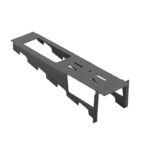A Cure for The Common Pedalboard – The RockBoard by Warwick Elevates the Humble Pedalboard to Flexible New Heights
trushack | Jan 16, 2018 | Comments 0
A Cure for The Common Pedalboard
The RockBoard by Warwick Elevates the Humble Pedalboard to Flexible New Heights
This writer still recalls a time when seeing a pedalboard in a rig was about as common a site as a pterodactyl. One reason was that everyone wanted to go with rack-mounted gear, but there were a couple of brand-specific options out there. Some folks were even industrious enough to go out and paint a piece of plywood and concoct a pedalboard that might last a gig or two. But for me and most of the players I knew, everything went on the floor and your fingers were crossed that your batteries wouldn’t die, your pedals would mostly stay put, and your patch cables (and ultimately your signal) would stay true. We can probably all agree that a pedalboard helps significantly dial down the stress levels when it comes to keeping things moving!
So even though the pedalboard itself may not have anything to do with the kinds of tones your rig generates, it definitely plays a significant role in signal path integrity. And we here at TheToneKing.com are excited about what the folks at Warwick are doing with their new RockBoard pedalboard line.
The RockBoard line looks fairly simple, but there’s a lot going on here. There is a wide range of sizes available: the Duo (18 1/8″ x 5 3/4″), Tres (20 1/16″ x 9 5/16″), Quad (two sizes, up to 24″ in length), and the Cinque (three sizes, up to 40 3/16″ in length). Each is available with a gig bag for jams around town or a pro-grade flight case to protect your pedals while they’re riding to the Enormo-dome in the trunk of your limousine (or maybe you just want the extra protection).

First and foremost, each RockBoard is constructed using one cold-rolled sheet of aluminum. There are no welds or other anomalies that can make pedal-mounting surfaces uneven or cause the pedalboard to wobble over time. Believe it or not, some pedalboard makers account for the annoying wobble inherent in their construction methods and even include instructions on how to twist your board back into shape. The RockBoard makes that completely unnecessary, as it should be.
When it comes to layout, the RockBoard pretty much rules. The surface’s slot designed is arranged to easily accommodate pedals of all footprints and designs, be it top-mounted or side-mounted jacks, wide casings, slim casings, treadle-equipped pedals, or just about any other option in the stomp box world. No matter how the jacks are laid out on your favorite pedals, the cabling can be easily routed underneath the surface for a clean look and additional protection from wear and tear. Adding Warwick’s Flat Patch cables or RockBoard N- and S-Connector plugs can free up even more space and probably sound better than what you’re using right now.
If your signal path routing requires a more sophisticated solution, nearly every model in the RockBoard line (except for the Duo) will easily accommodate a RockBoard Module patch bay. The RockBoard Module patch bay will let you manage all your connections in one central location and keep things extra-tidy and efficient. Run MIDI, USB, or XLR connections in your signal chain? The RockBoard Modules have you covered. And if you have an “always-on” pedal, like a preamp or a compressor, the RockBoard Module patch bay makes it easy to move this pedal to the underside of your RockBoard, freeing up space for an additional pedal up top.
Of course, one of the most integral components of any modern pedalboard is a power supply. For years there were only a handful of heavy duty options in this realm, but like everything else in the pedal-based market options abound. As you may have expected, the RockBoard is ready to handle whatever power supply keeps your signal chain humming. Recognizing that mounting a power supply underneath the board is the most favored solution, Warwick devised “The Tray,” a universal power supply mounting solution that requires no drilling (something this writer had to do with a brand-specific bracket in a pedalboard made by another company. It was a total mess.). Apply some velcro (or, in this writer’s opinion, 3M Dual Lock), attach The Tray, and off you go. The Tray doesn’t fit the compact Duo, but is a cost effective, no-brainer accessory for any other RockBoard in the line.
TheToneKing.com will be checking in with our friends at Warwick during our sojourn to Winter NAMM 2018 and you’ll see the RockBoard featured in an upcoming video, so keep an eye out for that coverage. But in the meantime, head on over to the RockBoard website, check out the full line of boards and accessories and options, and tell us in the comments what kind of board you would build. Take care, and Rock(Board) on!
LIVE DEMO VIDEO:
Tiny URL for this post:
Filed Under: Featured • Reviews • Accessories
About the Author:



























